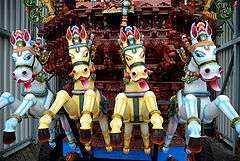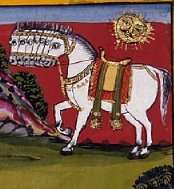Ashva

Aśvaḥ (अश्व) is the Sanskrit word for a horse, one of the significant animals finding references in the Vedas as well as later Hindu scriptures. The corresponding Avestan term is aspa. The word is cognate to Latin equus, Greek ίππος (hippos), Germanic *ehwaz and Baltic *ašvā all from PIE *hek'wos.
Vedic period
There are repeated references to the horse the Vedas (c. 1500 - 500 BC). In particular the Rigveda has many equestrian scenes, often associated with chariots. The Ashvins are divine twins named for their horsemanship. The earliest undisputed finds of horse remains in South Asia are from the Swat culture (c. 1500 - 500 BC).
Puranic legend

The legend states that the first horse emerged from the depth of the ocean during the churning of the oceans. It was a horse with white color and had two wings. It was known by the name of Uchchaihshravas. The legend continues that Indra, king of the devas, took away the mythical horse to his celestial abode, the svarga (heaven). Subsequently, Indra severed the wings of the horse and presented the same to the mankind. The wings were severed to ensure that the horse would remain on the earth (prithvi) and not fly back to Indra’s svarga.
In Baltic languages
The word Ašva is recorded as a noun meaning female horse in Prussian Lithuanians language. References however are few, as the word had almost fallen out of use at the time, and include: Lexicon Germano-Lithvanicvm et Litvanico-Germanicvm, darinnen... von Iacobo Brodowskij, Praecentore Trempensi (written somewhere between 1713 and 1744); Littauisch-Deutsches und Deutsch-Littauisches Lexicon. Königsberg. 1744; Littauisch-deutsches und Deutsch-littauisches Wörter-Buch. Königsberg. 1800; Littauisch-deutsches Wörterbuch von Friedrich Kurschat. Halle a. S.1883.; Wörterbuch der Littauischen Sprache von G. H. F. Nesselmann. Königsberg 1851.;
See also
References
| Wikimedia Commons has media related to Tempelwagen Hamm. |
- Dictionary of Hindu Lore and Legend (ISBN 0-500-51088-1) by Anna Dallapiccola
- Lietuvių kalbos žodynas